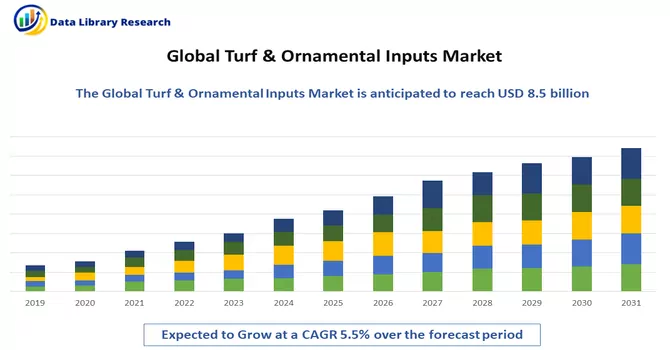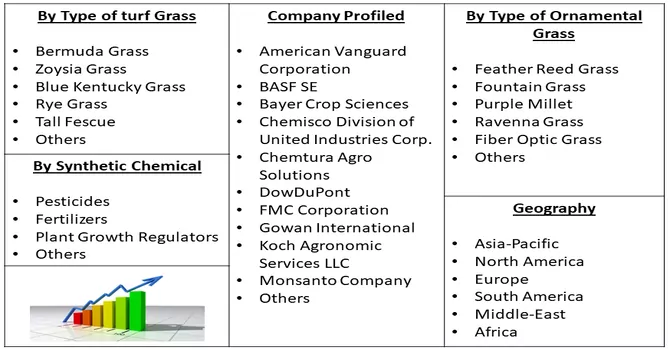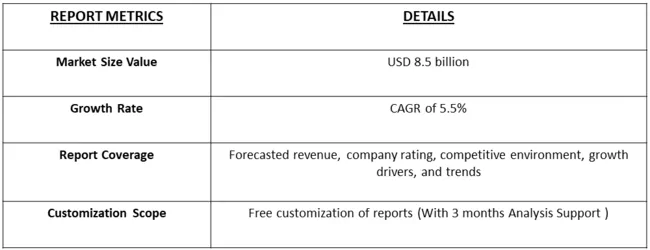The Turf & Ornamental Inputs Market size is estimated at USD 8.5 billion in 2023 and is expected to have a CAGR of 5.5% over the forecast period, 2024-2031.

Get Complete Analysis Of The Report - Download Free Sample PDF
The Turf and Ornamental Inputs market encompasses a diverse range of products vital for maintaining and enhancing the aesthetic appeal and health of turfgrass and ornamental plants. This sector caters to various end-users, including landscapers, golf course management, and residential gardeners. Key inputs in this market include fertilizers, pesticides, herbicides, and growth regulators designed to address specific needs in turf and ornamental plant care. With an increasing focus on sustainable and environmentally friendly practices, there is a growing demand for organic inputs and bio-based solutions within this market.
The Turf and Ornamental Inputs industry plays a pivotal role in supporting green spaces, sports fields, and ornamental landscapes, contributing to the overall well-being and visual appeal of outdoor environments. expanding global focus on green spaces, landscaping, and sports turf management. The increasing awareness of the environmental and aesthetic benefits of well-maintained turf and ornamental landscapes is propelling the demand for high-quality inputs. As urbanization intensifies and public spaces become more integral to community well-being, there is a heightened emphasis on professional lawn care, golf course management, and ornamental plant maintenance. Additionally, the growing trend towards sustainable and eco-friendly practices is steering the industry towards innovative, environmentally responsible inputs, further driving the market's growth. The combination of urban landscaping trends and a shift towards sustainable practices positions the Turf and Ornamental Inputs market as a key player in supporting and enhancing outdoor spaces worldwide.
Market segmentation: The Global Turf and Ornamental Chemical Inputs Market is Segmented by Type of Turf Grass (Bermuda Grass, Zoysia Grass, Blue Kentucky Grass, Rye Grass, Tall Fescue, and Others), Type of Ornamental Grass (Feather Reed Grass, Fountain Grass, Purple Millet, Ravenna Grass, Fiber Optic Grass, and Others), Synthetic Chemical Inputs (Pesticides, Fertilizers, Plant Growth Regulators, and Others), and Geography (North America, Europe, Asia-Pacific, South America, and Africa). The market size and forecast are provided in terms of value (USD million) for the above segments.

For Detailed Market Segmentation - Download Free Sample PDF
In the Turf and Ornamental Inputs market, several notable trends are shaping the industry landscape. One prominent trend is the increasing adoption of sustainable and eco-friendly solutions in response to growing environmental consciousness. This includes a rising demand for organic fertilizers, bio-based pesticides, and environmentally responsible herbicides, reflecting a broader industry commitment to reducing the ecological impact of turf and ornamental plant care. Another trend involves the integration of advanced technologies, such as precision agriculture and data-driven management practices, to optimize input usage and enhance overall efficiency in turfgrass and ornamental plant maintenance. Additionally, there is a growing focus on customized solutions tailored to specific regional and climatic needs, allowing the industry to address diverse challenges in different geographic areas. As the Turf and Ornamental Inputs market evolves, these trends underscore a commitment to sustainability, innovation, and precision in meeting the demands of modern landscaping and turf management practices.
Market Drivers:
Increasing Urbanization and Green Space Development:
The ongoing global trend of urbanization has led to a surge in the development of green spaces, parks, and recreational areas. As cities expand, there is a growing need for well-maintained turf and ornamental landscapes to enhance the aesthetic appeal of urban environments. This trend drives the demand for Turf and Ornamental Inputs, including fertilizers, pesticides, and growth regulators, to ensure the vitality and health of green spaces in both residential and commercial settings.
Rising Awareness of Environmental Sustainability:
With a heightened awareness of environmental issues, there is a growing demand for sustainable and environmentally friendly practices in landscaping and turf management. Consumers, businesses, and municipalities are increasingly seeking products that minimize the environmental impact without compromising performance. This shift in preference towards eco-friendly Turf and Ornamental Inputs, such as organic fertilizers and bio-based pesticides, acts as a strong driver in the market, influencing purchasing decisions and industry practices towards more sustainable solutions.
Market Restraints:
Market restraints for the Turf and Ornamental Inputs market include regulatory challenges and concerns related to chemical inputs. Stringent regulations governing the use of certain pesticides and fertilizers, often driven by environmental and health considerations, can pose obstacles for manufacturers and distributors. Compliance with evolving regulatory standards requires continuous adaptation and investment in research and development. Additionally, public awareness and scrutiny regarding the environmental impact of chemical inputs may lead to increased pressure for alternative, eco-friendly solutions. Economic factors, such as fluctuations in commodity prices, can also impact the cost of inputs, influencing market dynamics. Furthermore, the seasonal nature of the industry and external factors like weather conditions can contribute to market volatility, affecting demand and supply patterns. Successfully navigating these challenges requires industry players to prioritize innovation, sustainability, and regulatory compliance to ensure long-term viability in the Turf and Ornamental Inputs market.
The COVID-19 pandemic has presented both challenges and opportunities for the Turf and Ornamental Inputs market. The initial disruptions in global supply chains and logistical constraints impacted the availability of inputs, leading to uncertainties in the industry. Lockdowns and restrictions on public spaces temporarily reduced the demand for landscaping services, affecting the market. However, the pandemic also accelerated certain trends, such as the growing importance of outdoor spaces for recreation and well-being. With more people spending time at home, there has been an increased focus on residential landscaping, creating new opportunities for the Turf and Ornamental Inputs market. Furthermore, the heightened awareness of environmental sustainability has intensified, influencing a shift towards eco-friendly inputs. As the industry adapts to the post-pandemic landscape, the emphasis on sustainable practices and the integral role of green spaces in urban planning are expected to continue driving the Turf and Ornamental Inputs market.
Segmental Analysis:
Zoysia Grass Segment is Expected to Witness Significant Growth Over the Forecast Period
Zoysia grass, known for its lush and resilient characteristics, stands as a popular warm-season turfgrass appreciated for its dense growth, fine texture, and adaptability to various climates. Recognized for its ability to thrive in both sun and shade, Zoysia grass forms a dense, carpet-like turf that exhibits excellent heat and drought tolerance. This grass variety requires lower maintenance compared to some other turf types, making it a favoured choice for residential lawns, golf courses, and public spaces. Its slow growth pattern contributes to reduced mowing frequency, and once established, Zoysia grass exhibits strong resistance to pests and diseases. With different cultivars available, such as Meyer, Emerald, and Zeon, each with unique characteristics, Zoysia grass offers a versatile and aesthetically pleasing option for those seeking a durable and visually appealing lawn or turf surface.
Feather Reed Grass Segment is Expected to Witness Significant Growth Over the Forecast Period
Feather Reed Grass (Calamagrostis acutiflora), a perennial ornamental grass, has gained prominence in landscaping and horticulture for its elegant and architectural presence. Recognized for its upright growth habit, slender green stems, and feathery plumes that emerge in summer, Feather Reed Grass adds a distinctive visual appeal to commercial and residential landscapes. Its adaptability to various soil types and climates, coupled with minimal maintenance requirements, makes it a preferred choice for businesses seeking resilient and aesthetically pleasing landscaping solutions. This grass variety's ability to provide structure, texture, and year-round interest, especially in urban environments or corporate settings, aligns with the demand for low-maintenance yet visually impactful landscaping elements in the business landscape. Feather Reed Grass stands as a versatile and decorative asset, contributing to a professional and polished outdoor environment.
North America Region is Expected to Witness Significant Growth Over the Forecast Period
In North America, the Turf & Ornamental Inputs Market is a dynamic sector that plays a crucial role in shaping the region's landscaping, gardening, and horticultural practices. This market encompasses a broad range of products, including fertilizers, pesticides, seeds, and other inputs tailored for turfgrass and ornamental plant care. With a significant focus on maintaining lush lawns, vibrant landscapes, and appealing gardens, North America witnesses a robust demand for high-quality turf and ornamental inputs. The industry is characterized by ongoing innovations, addressing environmental concerns, and promoting sustainable practices. As homeowners, landscapers, and golf course managers seek efficient and eco-friendly solutions, the Turf & Ornamental Inputs Market responds with products designed to enhance plant health, mitigate pest issues, and promote sustainable land management practices. The North American market's adaptability to diverse climates and landscaping preferences makes it a vital hub for the development and distribution of turf and ornamental inputs, contributing to the region's aesthetically pleasing and well-maintained outdoor spaces.

Get Complete Analysis Of The Report - Download Free Sample PDF
The analyzed market exhibits a high degree of fragmentation, primarily attributable to the presence of numerous players operating on both a global and regional scale. The competitive landscape is characterized by a diverse array of companies, each contributing to the overall market dynamics. This fragmentation arises from the existence of specialized solution providers, established industry players, and emerging entrants, all vying for market share. The diversity in market participants is underscored by the adoption of various strategies aimed at expanding the company presence. On a global scale, companies within the studied market are strategically positioning themselves through aggressive expansion initiatives. This often involves entering new geographical regions, targeting untapped markets, and establishing a robust global footprint. The pursuit of global expansion is driven by the recognition of diverse market opportunities and the desire to capitalize on emerging trends and demands across different regions. Simultaneously, at the regional level, companies are tailoring their approaches to align with local market dynamics. Regional players are leveraging their understanding of specific market nuances, regulatory environments, and consumer preferences to gain a competitive edge. This regional focus allows companies to cater to the unique needs of local clientele, fostering stronger market penetration. To navigate the complexities of the fragmented market, companies are implementing a range of strategies. These strategies include investments in research and development to stay at the forefront of technological advancements, mergers and acquisitions to consolidate market share, strategic partnerships for synergies, and innovation to differentiate products and services. The adoption of such multifaceted strategies reflects the competitive nature of the market, with participants continually seeking avenues for growth and sustainability. In essence, the high fragmentation in the studied market not only signifies the diversity of players but also underscores the dynamism and competitiveness that drive ongoing strategic manoeuvres. As companies explore various avenues for expansion, the market continues to evolve, presenting both challenges and opportunities for industry stakeholders.
Recent Development:
1) In March 2022, BASF introduced the Pillar SC Intrinsic brand fungicide, representing a significant advancement in lawn care. This innovative fungicide offers broad-spectrum control, targeting 26 cool- and warm-season turf diseases, including brown patch, dollar spot, leaf spots, and large patch, all with a single use rate. Notably, Pillar SC Intrinsic is BASF's inaugural fungicide specifically designed for lawn care, highlighting the company's commitment to delivering effective solutions for turf management.
2) In January 2022, Syngenta Crop Protection AG strengthened its portfolio by acquiring two cutting-edge bioinsecticides, "Nematrident" and "Unispore." This strategic move aims to address the growing challenges of insect resistance and diverse pests across horticulture, ornamentals, turf amenity, and forestry. By incorporating these next-generation bioinsecticides, Syngenta demonstrates its dedication to providing sustainable and effective pest control solutions for a wide range of applications within the agriculture and landscaping sectors.
Q1. What was the Turf & Ornamental Inputs Market size in 2023?
As per Data Library Research the Turf & Ornamental Inputs Market size is estimated at USD 8.5 billion in 2023.
Q2. At what CAGR is the Turf & Ornamental Inputs Market projected to grow within the forecast period?
Turf & Ornamental Inputs Market is expected to have a CAGR of 5.5% over the forecast period.
Q3. What are the factors driving the Turf & Ornamental Inputs market?
Key factors that are driving the growth include the Increasing Urbanization and Green Space Development and Rising Awareness of Environmental Sustainability
Q4. What segments are covered in the Turf & Ornamental Inputs market Report?
By the Type of Turf, By type of Ornamental Grass, By Synthetic Chemical Input and Geography these segments are covered in the Turf & Ornamental Inputs market Report
Data Library Research are conducted by industry experts who offer insight on industry structure, market segmentations technology assessment and competitive landscape (CL), and penetration, as well as on emerging trends. Their analysis is based on primary interviews (~ 80%) and secondary research (~ 20%) as well as years of professional expertise in their respective industries. Adding to this, by analysing historical trends and current market positions, our analysts predict where the market will be headed for the next five years. Furthermore, the varying trends of segment & categories geographically presented are also studied and the estimated based on the primary & secondary research.
In this particular report from the supply side Data Library Research has conducted primary surveys (interviews) with the key level executives (VP, CEO’s, Marketing Director, Business Development Manager and SOFT) of the companies that active & prominent as well as the midsized organization
FIGURE 1: DLR RESEARH PROCESS

Extensive primary research was conducted to gain a deeper insight of the market and industry performance. The analysis is based on both primary and secondary research as well as years of professional expertise in the respective industries.
In addition to analysing current and historical trends, our analysts predict where the market is headed over the next five years.
It varies by segment for these categories geographically presented in the list of market tables. Speaking about this particular report we have conducted primary surveys (interviews) with the key level executives (VP, CEO’s, Marketing Director, Business Development Manager and many more) of the major players active in the market.
Secondary ResearchSecondary research was mainly used to collect and identify information useful for the extensive, technical, market-oriented, and Friend’s study of the Global Extra Neutral Alcohol. It was also used to obtain key information about major players, market classification and segmentation according to the industry trends, geographical markets, and developments related to the market and technology perspectives. For this study, analysts have gathered information from various credible sources, such as annual reports, sec filings, journals, white papers, SOFT presentations, and company web sites.
Market Size EstimationBoth, top-down and bottom-up approaches were used to estimate and validate the size of the Global market and to estimate the size of various other dependent submarkets in the overall Extra Neutral Alcohol. The key players in the market were identified through secondary research and their market contributions in the respective geographies were determined through primary and secondary research.
Forecast Model
